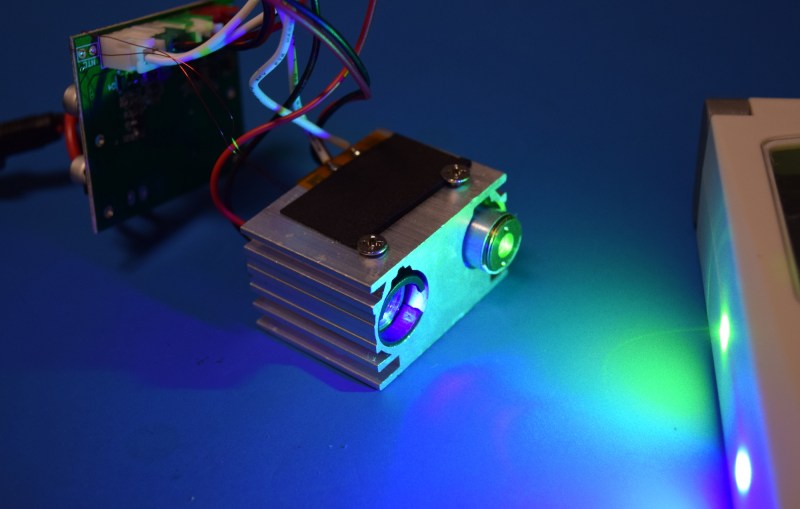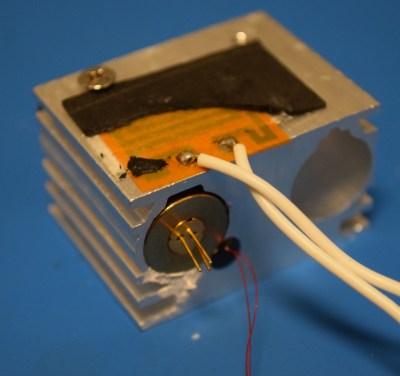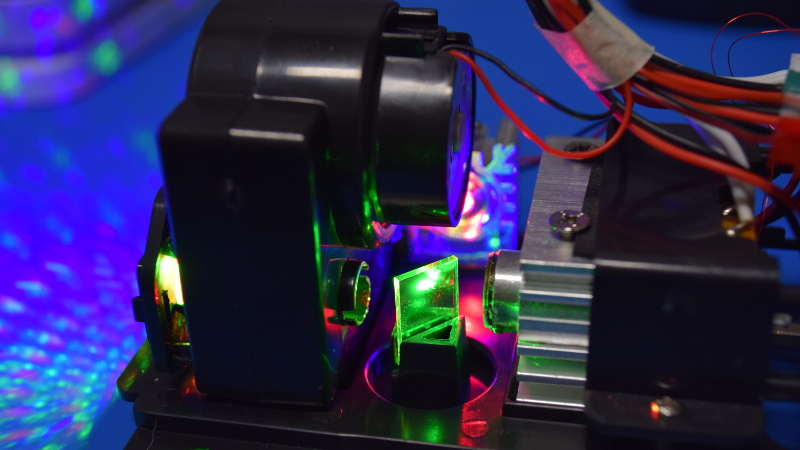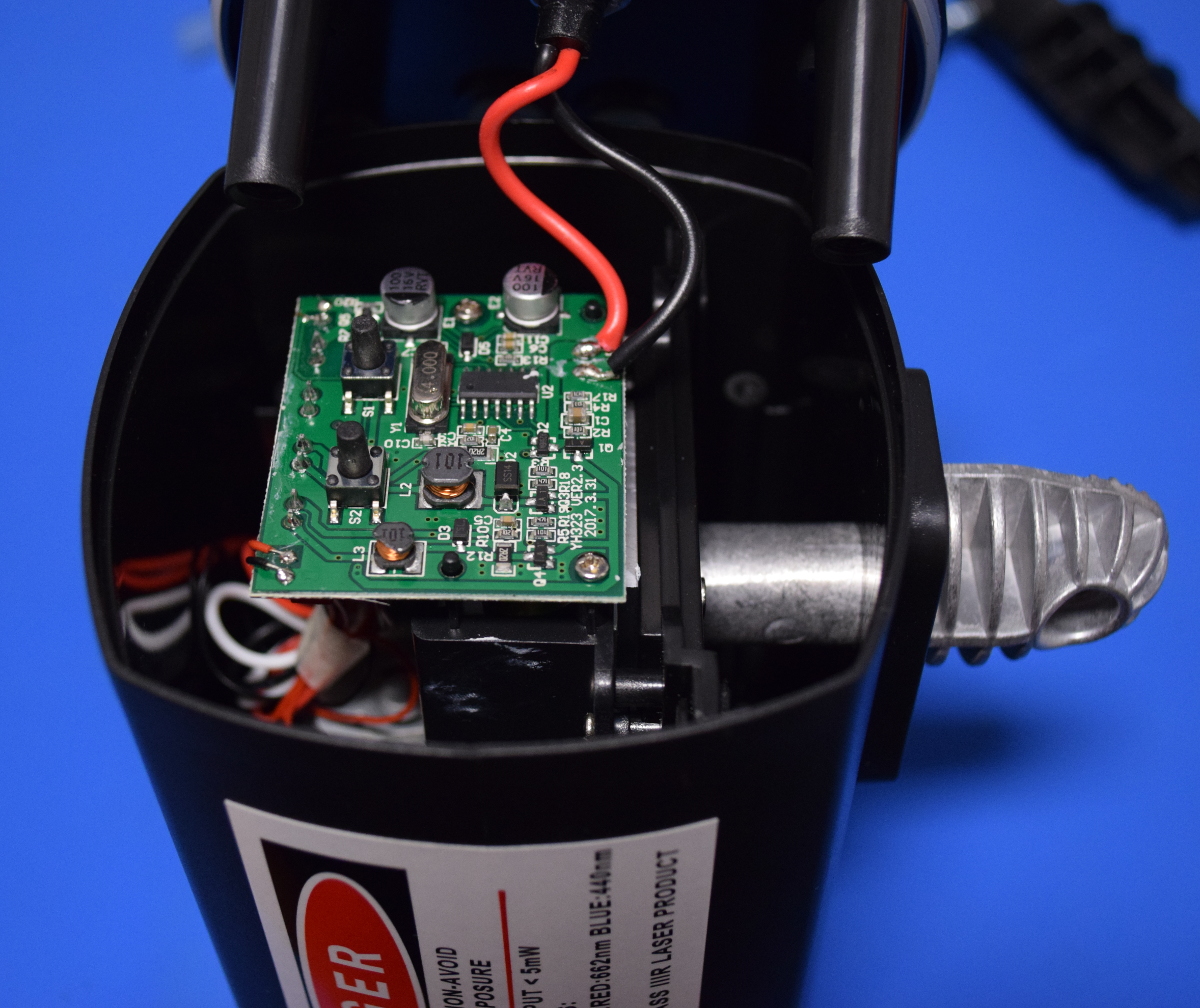In the world of big-box retail, December 26th is a very special day. The Christmas music playing on the overhead speakers switches back to the family friendly Top 40, the store’s decorations get tossed in the compactor, and everything that’s even remotely related to the holiday is put on steep clearance. No more money to be made on the most commercialized of all holidays, so back to business as usual.
 It’s in this narrow corridor of time, between the Great Holiday Unloading and the new spring products coming in, that you can find some fantastic deals on Christmas decorations. Not that long ago, this would hardly be exciting news for the readers of Hackaday. But Christmas lights and decorations have really started pushing the envelope in terms of technology: addressable RGB LED strands, Bluetooth controlled effects, and as of the last couple years, friggin’ lasers.
It’s in this narrow corridor of time, between the Great Holiday Unloading and the new spring products coming in, that you can find some fantastic deals on Christmas decorations. Not that long ago, this would hardly be exciting news for the readers of Hackaday. But Christmas lights and decorations have really started pushing the envelope in terms of technology: addressable RGB LED strands, Bluetooth controlled effects, and as of the last couple years, friggin’ lasers.
That’s right, you’ve seen them all over the neighborhood, probably took a few stray beams to the eye, you might even own your own. Laser projectors have been one of the most popular Christmas decorations for the last couple of years, and it’s not hard to see why. Just set the projector up in front of your house, and you’re done. No need to get on a ladder and string lights on the roof when you can just blast some directed energy up there instead.
Given how popular they are, I was surprised to see a lone Home Accents Holiday Multi-Color Light Projector on the clearance rack at Home Depot for around $14 a few days after Christmas. This was a 75% price reduction from normal MSRP, and right in that sweet impulse-buy price range. Let’s see what’s hiding inside!
Cracking it Open
This particular projector isn’t much different from other’s I’ve seen, except for the fact that it actually has three lasers inside. Usually these projectors are just packing red (662 nm) and green (532 nm), but this one has a blue (440 nm) laser as well. Interestingly, there are only two laser apertures in the front of the unit, which means there must be some kind of beam combiner inside that’s allowing two of the lasers to shoot through one window. Presumably it was cheaper and easier to tack a beam combiner into the design than get new cases injection molded.
Four screws on the back of the unit allow you to pull off the cover, which I was somewhat impressed to see had a decent rubber seal around the edge to keep water out. With the back cover off you notice the first interesting element of this projector’s design: the external heatsink.
I had wondered why they used a metal “knuckle” on the mounting stake, and assumed that the finned design of the piece was just to reduce the material needed. But as it turns out the knuckle is connected directly to the primary laser heatsink by means of a solid metal cylinder, they even put a little bit of thermal conductive material on the mating surfaces. It’s not perfect, but at least it gets some thermal mass outside of the airtight body.
Getting a Closer Look
After removing the external heatsink, the “sled” containing all of the internal hardware slides easily out the back. All of the components of the device are easily accessible, and they’ve even gone as far as using connectors for most of it instead of soldering everything directly to the PCB in the back. It’s like they wanted us to strip it for parts.
The largest components are the motorized optics in the front of the sled, and the primary heatsink at the rear containing the blue and green lasers. The red laser is mounted in the smaller heatsink, positioned 90 degrees from the other lasers. This positioning is necessary for the beam combiner (the small angled piece of glass visible in the center) to send both the red and green beams out of the same aperture.
Examining the Lasers
Obviously the lasers themselves are the most interesting part of this device, so let’s get right to the good part: pulling them out. The main heatsink comes off the sled with a couple of screws on the bottom, and it leaves you with a nice little dual-laser module for doing experiments with. The red laser and its heatsink are also easily removed, but let’s be honest: nobody’s interested in red lasers anymore.

The attentive reader might notice from this picture that the lasers are way out of focus: at 3 meters, the spots looked as large as dinner plates. This is easily fixed by using a small pair of pliers on the focusing rings on the front of each laser. Once focused, it becomes pretty clear that these lasers are quite a bit more powerful than the < 5 mW listed on the product’s warning sticker.
In fact, once the blue laser was focused I was easily able to burn pieces of paper and punch holes in black plastic. As for the green laser, it is at least twice as bright as my green laser pointer which is labeled as 50 mW. I don’t have the equipment to measure the actual power of these lasers, but it would certainly not surprise me if they are both at least 100 mW.
Thermal (Mis)Management
 Impressively, the designers of this laser put a considerable amount of thought into thermal management. Not only is there a temperature sensor embedded into the heat sink to monitor for thermal shutdown, but there’s actually a tiny heating pad that’s used to bring the laser up to operating temperature in extremely cold conditions.
Impressively, the designers of this laser put a considerable amount of thought into thermal management. Not only is there a temperature sensor embedded into the heat sink to monitor for thermal shutdown, but there’s actually a tiny heating pad that’s used to bring the laser up to operating temperature in extremely cold conditions.
In the closeup image, you can see the thermal sensor (thin, red wires) and the heating pad are both clearly centered on the laser occupying the left position in the heatsink, which happens to be the green laser. Strangely enough, the blue laser sits in a black plastic sleeve that completely isolates it from the heatsink.
If you run both lasers out of the heatsink, you’ll find that the blue one gets hot to the touch in just a few minutes, while the green still feels like it’s at ambient temperature. It seems from this simple test that the blue laser is the one that needs more thermal babysitting.
If that’s the case, it was potentially meant to be installed in the left side of the heatsink, and yet somehow ended up being installed on the right. In fact I’m willing to bet that the blue laser will almost certainly burn out of these projectors after extended use, as in its current configuration it has essentially no cooling at all.
Blue Laser Playset
If your biggest take-away from this post is that the Home Depot is selling a 440 nm laser you can use to burn stuff, I certainly don’t blame you. If that’s what you’re after, I’d advise putting the blue laser in the red laser’s heatsink. Both laser modules are the same size, and the smaller heatsink should be more than enough in open air. You can then disconnect everything else from the control board, leaving only the blue laser remaining.
But before you power it up, you’ll have to solder in a resistor to take the place of the temperature sensor, or else the control board cuts power to the laser after a few seconds. The sensor reads around 50 KΩ at ambient temperature, so replacing it with something along those lines should keep it happy. In the following image you can see the 40 KΩ resistor I’m currently using.
What’s Worth Salvaging?
I’ve been on something of a salvage kick for a while now, so I often think of purchases like this in terms of what kind of useful hardware I was able to extract. For $14, I’ve got to say this is a pretty decent score:
From the optics section we’ve got a nice little geared motor, a beam combiner, and four optical gratings. Three laser modules and a driver board than can power any combination of them at once. Two heatsinks, one with an integrated temperature sensor. A tiny little heat pad, and finally a rugged looking 5V/2A adapter.
By the time you read this it’ll probably be too late to snap one of these up yourself, but there’s always next year. Who knows what dejected goodies will be lingering on the shelf come New Years 2018?
Do you have ideas for other interesting finds we can tear down? Let us know in the comments below.

























I had a couple of the older ones from a few years ago. Just red and green lasers. One of them gave up the ghost, the green laser stop working and the red barely working. I didn’t go into detail trying to determine what exactly went wrong, I do recall comparing voltages between the functional unit and the bad one only to determine that, yeah, the green is dead, not the driving circuit.
So, I have one left, will see how long it last but, honestly, I do not expect much…..
Depending on how much abuse the green has taken physically, it’s possible the diode is out of alignment with the crystal. Check to see if it is emitting IR.
A dead diode (damaged mirror facets of the semiconductor) can still have the same forward voltage as a working diode. It just does not emit significant amounts of laser light.
I would suspect that the laser power rating is based on the diffraction grating breaking the beam up. No individual beam is more than 5 mW.
Personally, I would not open one of these things up. I value my eyesight too much, and I don’t own any laser safety goggles. Do they even make goggles that cal block red, green, and blue all at the same time, without being completely black?
Good point on diffraction, it could be they come in under the 5 mW FDA guideline because the individual beams don’t exceed that.
“No user serviceable parts inside.”
“No serviceable part users inside.”
LOL! what a lie. Most people who visit here rip everything apart…
Almost everything dear boy. Almost everything…
No USER seviceable components… neither MAKERS nor HACKERS were addressed. C’mon… Cars are even hard to change the oil filter. When I was 8 and needed a dual-ganged on-off/volume control knob on my shortwave replaced the shop wanted $2 for the part and $2 labor. I only had $2. I asked why they could not simply fix the switch… Not even glancing up from his bench, he said, “Hermetically sealed.” I went home and opened and fixed the switch. WE… are not USERS. We never were, I suspect.
“WE… are not USERS. We never were, I suspect.”
Quoted for truth.
Okay, so, I bought one of these. Overcame the security screws against my better judgement, yanked out the interesting bits (green laser and driver) and modified it to run off of an 18650 battery. Any idea how I might calculate the wattage of the single beam with the assumption that a single beamlet is on average just less than 5mw (presuming I summon the patience to count the number of beamlets the diffraction grating produces.) No luck locating schematics or datasheets :(.
Warning: I know jack shit about lasers.
They have laser meters that will do that but, I understand they are expensive.
So, I would measure the wattage going to the laser when operational. That would give you an idea. I’m not sure about the conversion efficiency. I think you’d be in the ball park.
Well if it lights something on fire like the laser from this projector did, then assume it’s a bit north of 5 mW.
Realistically, you can get laser power meters online, but even the suspect Chinese ones are going to be in the $100 range, and without another laser to verify its readings you have to just trust it’s calibrated properly.
You are a man after my own heart. Buying something just for the joy of taking it apart to see how it works (and add to your parts bin).
I suspect most here got their start that way. There’s a reason the family car doesn’t run right. ;-p
Au contrair: the family car runs BETTER
MUCH better… My AC blows 20*f air on a day when it is 105*f outside, power and throttle response is 50% better than from the factory, fuel mileage is improved, and the car is silent while at idle (accidently left the motor running after a rebuild, a couple hours later I got in and thought the tac was stuck… till I tapped the gas peddle…)
I’ve made a career out of building something new using parts I got from other devices. Some parts are just hard to get for your prototypes, so stealing them from things you can buy off the shelf is often the best way to get small numbers of parts for a prototype. When I built a smartphone prototype in 1987, nearly all of the chips were pulls from something else. I got a few things as samples, but back then ordering 5 or 10 of something from a chip maker was nearly impossible. They often would give you samples for free, if they had some excess from a manufacturing run, but they didn’t keep inventory on anything normally. We were not a manufacturer, just a design firm, so we didn’t have the buying power to get much attention from the chip brokers.
I will second that. Grew up with that way of thinking from an early age. Not sure where it came from. Nobody else in the family has the slightest interest.
Nothing better than tinkering.
+1
I came by my interest honestly, as my dad is a mechanic who loves to figure out WHY it broke, rather than just fix what broke.
That said, I started tearing things apart before I could experience his wrenching inclination.
My parents tell of the dread “quiet child” and coming out to find that I’d disassembled the floor lamp at my grand-parents house, while it was still plugged in, at all of 2 years old.
There’s a reason it’s called the “terrible twos”.
True dat, good sire.
So should we be alarmed that people are waving ~100 mW lasers all over their house and street, while being told that they’re using much safer 5 mW lasers?
Or maybe the rating was talking about the individual power of each dot, and the beam is being split up 20-odd ways?
I guess as long as the beam is being diffracted, and not just reflected, it should be fine.
Laser Maestro Styropyro would say so:
https://www.youtube.com/watch?v=-2crWR1lg6s
Are there any usage restrictions on these projectors especially at locations near airports? I’ve seen people projecting them up at trees, which look really cool and all, but I wonder if stray beams could cause issues similar to people pointing laser pointers at airplanes and helicopters.
Absolutely. Blind an airliner with one and you’re in trouble if caught. It just shifts the charge from intentional to negligent.
In general using them outside is restricted to people with licenses similar to HAM operators. You won’t really get in trouble by local law enforcement though unless you are caught pointing at traffic or aircraft. Last I heard, pointing a class 3 laser at any aircraft is a felony and holds a two year mandatory sentence, if convicted.
My guess on that is that the diffraction and focus issues, out of the box, the light coming out of these things would be nothing to a plane overhead. I think they’d be so diffused, I wonder if they’d even be visible if they were pointed straight up in a flight path….
Take them apart and focus the beams, on the other hand, and you’re in a world of trouble if you get caught.
First of all the beams move about, second they diverge madly (I expect on purpose) and third of all, a stray laser hitting a plane for a second won’t harm it even if it wasn’t so divergent.
But I’m sure you comment is welcome on BBCNews’s twitter or some such.
could this be hack to make your own image?
My thoughts exactly.
I see no reason why not.
Definitely a possibility with R/G/B lasers. Doesn’t seem like the optics in this thing are going to be any help, but at least you’ll have a cheap/local source for the diodes (well, if you luck out anyway).
I’ll wager that the Blue diode has a different case polarity. Therefore insulated from the heatsink.
Isolate the green one then?
make it 2 Heat Sinks.
I am deeply saddened that I missed out on the fire sale at Home Depot. I have been known to buy deeply discounted items to use in other projects, though for that I tend to visit year sales.
I saw one in a neighborhood this year. At a yard sized distance, one of the colors in the eye was easy to miss and nothing to worry about. It was a little foggy and by moving my head around I could barely see the beams and not at all if I was about 10 minutes of arc (3 mrad) off the axis.
I bought one of these at the SEG in Shenzhen in about 2012. There were being used all over by aiming at the floor to catch attention at a booth, and only one person had them for sale. We thought about selling them for Xmas but the liability problem was too big a hurdle.
Outdoors, the green laser quit when the temperature dropped to near freezing. I figured it was from the KDP crystal lattice changing spacing until it could not match the IR from the diode. So, no good in snow country without an internal heater. We tried it as an alternative to lights on a tree and it really takes at least two of them, and mounted ceiling high to keep kids from staring in the hole. It is OK for store displays if it was a lot brighter but store owners will think better of it if anyone mentions laser power limitations, etc. Cool gizmo though. I was really amazed to find them for under $30. And we had never heard of such a thing until we stumbled across them in person.
I like pointing mine into the trees, it looks like lights are on the trees, and the slightest movement makes them “twinkle”.
A lot of these projectors didn’t get sold this XMAS. I think our local hardware chain overstocked big time. Sad thing is that the demo packaging sells 8 or more while powering a sample unit in the middle with a push button and on-board batteries. This likely gets crushed and thrown out. Sad. I’d but it for 15 cents on the dollar!
Mr. Christmas Programmable Lite-Write Laser Show projects images, messages and has music output. They were half price after XMAS and come with an LCD key-pad to program your own message. Must have some sort of X and Y beam control. Really wanted to buy this, if anyone had already spent some time to tear it apart and show what makes it tick inside. Right in the store on my phone, I Googled if there were any hacks on this product… spent ten minutes doing all sorts of keyword search variations and sadly… didn’t find any.
Hello there, not sure this will get any looks. We have searched online the past 2 years as we HAVE one these But the damn thing is out of focus!?!? We think it may be a simple fix and have not trashed it yet because it was retail about$150 but my wife scored it at 90% off. It was awesome 2-3 yes ago, but the next year, it fell outta focus!!! Lasers still turn on and project, but diffused figures that are outta focus.
Trying to salvage/repair but having no luck finding the issue/repair :(
Anyone here have any idea!!! It was our greatest holiday display but lived far too short and have not seen any like it :(
Still available, Everyone!
https://www.homedepot.com/p/Home-Accents-Holiday-RED-BLUE-GREEN-LASER-PROJECTOR-TYY1086-1715/301683520
Can’t add to cart, not available online. Sigh.
Didn’t notice that, sorry.
The green laser is probably DPSS which I think is still cheaper than direct injection green. DPSS is pretty critical when it comes to internal temps to operate efficiently. Not only is there and issue with the temp that the SHG crystal wants to be at, but the Nd:YVO4 crystal itself is wavelength dependent and the diode wavelength will change with temperature. But mainly you just got to keep the things warm, green pointers are used in astronomy a lot and they start loosing power big time when it gets cold out so they sell ones with heaters built in.
The blue diode on the other hand does not care so much. They can take up to about 70c at the case.
Still strange to insulate it from the heatsink with a plastic collar though, no?
Why make a dual heatsink in that case? It seems like somebody screwed up somewhere, or at least they were trying to reuse existing dual-sinks from an earlier version where both lasers were the same diameter.
So you have a red a green and a blue LASER. Where’s the LASER video projector build? ;)
Posted six years ago – hackaday.com/2011/12/31/full-color-laser-tv/
Am I really the only one who spotted the reference in “Blue Laser Playset”?
Some time ago someone on Hack A Day built a monochrome projection microscope by shining a laser through a hanging drop containing living creatures. Using the three lasers from this gadget you could get the same in full colour, though it might be very difficult to align the beams.
I bought a similar unit from a DJ equipment place last fall, as disco lighting for my wife’s (redacted)-th birthday party. It is just red-green, but has the remote control and was music activated. This unit was a bit more expensive and has a better case than the Christmas ones… but I’ll bet it’s got pretty much the same mechanisms inside.
So when the motor/diffuser gets stuck for any reason, and the kids go over to lok inside when it’s not ‘working’.
Who’s responsible for the medical billls?
has anyone hacked one of these to make them come on at power on automagically? I wanna use them for an effect for a showchoir .. and control via DMX relay .. any thoughts appreciated.
Yes, I actually did this last night. For the one I have:
1. Remove from housing entirely.
2. Jumped the red and black wires on the white block that has 3 cables going to it, not the white block with 2 cables. This results in the red and green laser being on 24/7 so long as the rig has power.
3. Jump the red cable on the brown block with the red cable on the red cable of the white 3 block connector. This enabled the motor the always run. Stock option would force you to press the button to enable the motor for motion. Motor is now on 24/7
4. My laser has a photovoltaic sensor on the front, and automatically disables the lights if the sensor detects even a small amount of light. Previously I just put a piece of electrical tape over the sensor. Since I already had the thing taken apart, I also jumped these to remove the sensor entirely.
Next up, I am going to mount everything on top of an old IP PTZ Camera, and wire the laser project directing into the PTZ platform. Maybe I will write up something for everyone once I am finished.
I bought one on a 90%off clearance at my local Meijer. Paid $4, well worth it for such powerful red and green lasers. They’re not strong enough to burn anything but they’re far brighter than any LED or HeNe gas laser I have.
I haven’t done hardware hacking in nearly 30 years, but what I am interested in is one of these laser projector decoration that it’s possible to connect to and direct where it points and when it points there. And of course on the cheap 😂 I have a fun clock project in mind if I can find something like that 🙏🏻